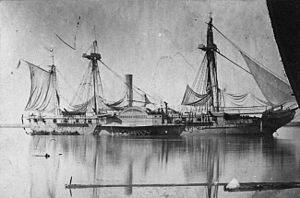USS Mississippi (1841)
 |
|
| History | |
|---|---|
| Name: | USS Mississippi |
| Builder: | Philadelphia Navy Yard |
| Laid down: | 1839 |
| Launched: | 1842 |
| Commissioned: | 22 December 1841 |
| Fate: | Scuttled, 14 March 1863 |
| General characteristics | |
| Type: | steam frigate |
| Displacement: | 3,220 long tons (3,272 t) |
| Length: | 229 ft (70 m) |
| Beam: | 40 ft (12 m) |
| Depth of hold: | 19 ft (5.8 m) |
| Propulsion: | Steam engine |
| Speed: | 8 knots (15 km/h; 9.2 mph) |
| Armament: |
|
USS Mississippi, a paddle frigate, was the first ship of the United States Navy to bear that name. She was named for the Mississippi River. Her sister ship was Missouri. Her keel was laid down by the Philadelphia Navy Yard in 1839; built under the personal supervision of Commodore Matthew Perry. She was commissioned on 22 December 1841, with Captain W. D. Salter in command and launched several weeks later.
After several years of service in the Home Squadron, during which she performed experiments crucial to development of the steam Navy, Mississippi joined the West Indian Squadron in 1845 as flagship for Commodore Perry. During the Mexican-American War, she took part in expeditions against Alvarado, Tampico, Pánuco, and Laguna de Términos, all successful in tightening American control of the Mexican coastline and interrupting coastwise commerce and military supply operations.
She returned to Norfolk for repairs on 1 January 1847, then arrived at Veracruz on 21 March 1847, carrying Perry to take command of the American fleet. At once she and her men plunged into amphibious operations against Veracruz, supplying guns and their crews to be taken ashore for the battery which fought the city to surrender in four days. Through the remainder of the war, Mississippi contributed guns, men, and boats to a series of coastal raids on Mexico’s east coast, taking part in the capture of Tabasco in June 1847.
...
Wikipedia
